HAVE YOU CONSIDERED GETTING OFF THE GRID?
You may have occasionally wondered if there was an alternative to purchasing your electricity from Ontario Power Generation. Perhaps this happens when you realize your electrical bill is seemingly increasing at an alarming rate, or during times you experience inconvenient power failures, leaving you with that helpless feeling while you hope your plea for power restoration is heard so your life may continue as planned. For a long time we have had no other choices but to purchase our power from Ontario Power Generation, formerly known as Ontario Hydro, with alternative solutions often very costly and impractical at best.
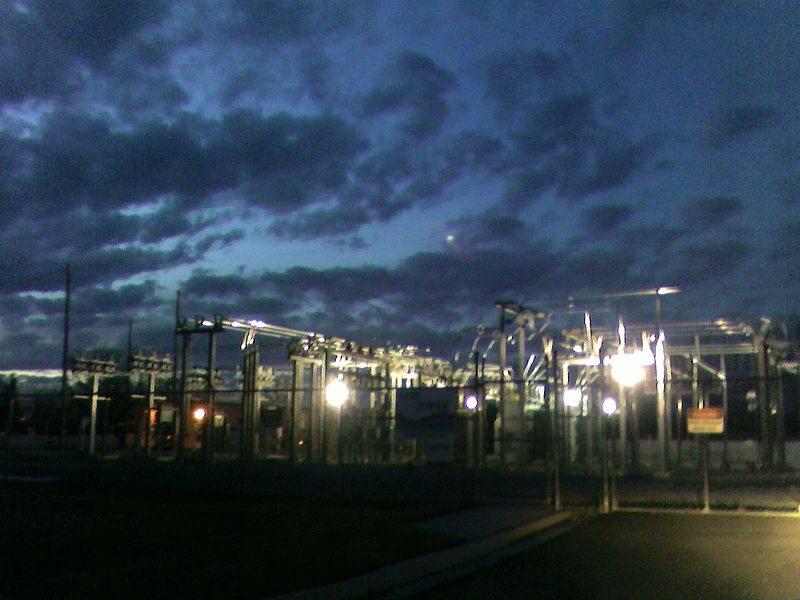 |
Click here to learn more about your electrical bill and the challenges faced by Ontario Power Generation OPG provides electricity to Ontario residents as long as the lines are up and the bill is paid. However, weather patterns, political decisions, environmental variables, and the aging grid continually pose challenges to OPG in delivering reliable and affordable power. Furthermore, you may have property located too far from OPG facilities to make a grid connection practical. |
Now you have the option to get off the grid in an affordable way. If you have a home in a rural or semi-rural setting, and are willing to make some lifestyle adjustments, you are certainly able to get off the OPG grid and enjoy producing your own solar electricity with a system designed to last you a lifetime.
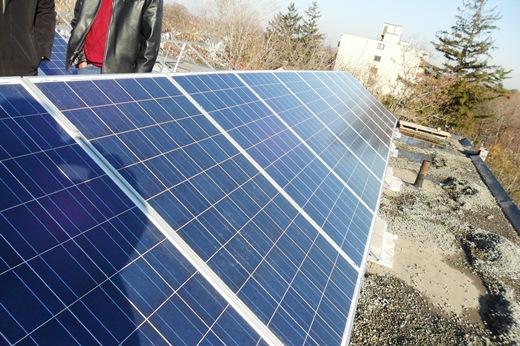 |
Having your own solar electrical system can be rewarding and give flexibility in your life... |
What is different about having a solar electrical system compared to being on the grid?
There is a limit to how much power you can draw at once...
The major difference between having an OPG grid connection versus your own solar off-grid system is in the amount of available power you have at a single moment. You may have heard of your residence having a 200 Ampere service from OPG. This means you can draw up to 200 Amperes at 120 volts, translating to 24000 watts of power from your electrical outlets at one time. Heavy draw appliances such as heaters, toasters, coffee machines, hot water tanks, and electric clothes dryers are typical high-draw items which you can commonly use with an OPG connection all at the same time.
With a solar electrical system, just like with any small self-contained system, there is a limit to how many high-draw appliances can be run simultaneously. A typical small off-grid system can supply 25 Amperes equalling 3000 watts of power to the house at the same time, meaning you can certainly run a toaster together with a refrigerator and a few lights, however, you could not run a toaster and a coffee machine at the same time or you will exceed the maximum your system can provide at once. In this case you would finish making the coffee and then make the toast, or, turn off the coffee machine for the few seconds the toaster is working and then resume the coffee once the toast is finished. If this is difficult to adjust to, it is certainly possible to increase the capacity of the electrical system if preferred.
 |
Click here to see how much common appliances use in Watts.... In order to make solar electrical work for you, it is best to understand how much your appliances use and what you have available in electrical output, and adjust your consumption accordingly. This means you can run the low draw appliances freely, and restrict the use of the high draw appliances using them only when absolutely necessary and when there is a good amount of sunshine shining on your solar panels! |
Low, medium, high, and super-high draw electrical appliances...
Appliances can be categorized in four groups, including those of low, medium, high, and super-high electrical consumption. Examples of common appliances are as follows:
- Low consumption, such as those consuming 30 watts or less, include alarm clocks, compact-florescent or LED light bulbs, laptop computer, radio and stereo
- Medium draw appliances, typically 30 - 400 watts, include desktop computer systems, television, efficient refrigerators, incandescent light bulbs, small power tools
- High draw appliances, using 500 - 1500 watts include power tools, vacuum cleaners, toasters, microwave ovens, washing machines
- Super-high draw appliances, using over 1500 watts, include electric hot water tanks, clothes dryers, electric heaters, electric ranges
In order to make solar electrical work for you, it is important to first find a substitute for any super-high draw items in your household. If you have electric hot water tanks, baseboard heaters or electric furnaces, electric clothes dryers, or an electric cooking stove/range, it is best to trade your appliances in for those run by an alternative source of energy such as propane, natural gas, or wood. Producing heat with Solar electrical is impractical because your system is small and economical, tailored to fit the needs of your household electrical consumption, such as gadgets and systems which must run with electricity. Producing heat with solar is best done non-electrically, such as through passive solar and rooftop hot water systems using direct solar heat transfer rather than having an electrical conversion. Your solar electrical system is designed to run low, medium, and occasionally the high-draw appliances only. Certainly it is possible to build a system to run your super-high appliances as well, but they would run in excess of $50,000 per system, compared to the price of $5,000 - $22,000 for very functional solar electrical off-grid systems.
Planning your power useage
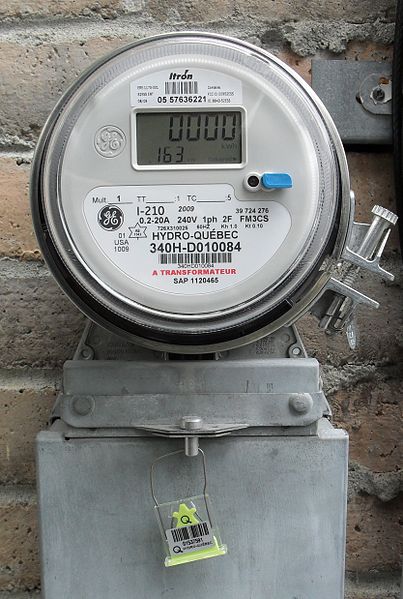 |
Just like with OPG, you have to adjust your time of day useage, but for a different reason... One of the great advantages to your solar electrical system is that it produces the most power during the day when the sun shines. This is when you plan to use most of your free electricity, including using your high draw appliances. Once the sun sets, you reduce your consumption to keep from discharging the batteries... |
More on appliances and consumption...
In order to minimize the cost of producing power through solar energy, it is adviseable to look closely at your electrical appliances and make sure they are running as efficiently as possible.
A consultation on economizing your electrical consumption may be something you'd consider, discovering ways to economize your electrical useage and allowing you to maximize on your solar electrical experience. Simply put, the more power saving tricks you come up with through investing in economical appliances, changing light bulbs, placing cooling appliances in strategic rooms of your home, etc; the smaller a solar electrical system you will need to serve your household needs. And a smaller system means you spend less money.
Remember from what you read on the OPG facts page, reducing your electrical consumption as an OPG customer raises your electrical costs per unit of power, so putting such economizing measures in place while connected to OPG does not necessarily translate to savings, however, with your solar electrical system, it can mean a difference of needing a 2 KW system or a 3 KW system.
The sun and the clouds
It would be ideal for your solar power system to have full sunshine every day. However, Eastern Ontario has an average of about 200 sunny days per year, with most of the other days either partially sunny or completely overcast.
 |
Storms, cloudy and overcast weather conditions greatly affect your daily power production... |
A solar system is generally over-designed to accommodate power useage on cloudy days. For example, if your minimum daily power consumption is 3 kilowatt-hours, a system rendering 10 KW-hrs is ideal, as this gives your system the ability to store excess power on sunny days into your batteries for use on the next cloudy day. Your consumption habits also need to be adjusted to weather conditions for the optimal solar experience. This means that while the sun is shining, it is best to then use higher-draw electrical appliances such as the washing machine and vacuum cleaner, allowing your solar system to apply the excess produced due to the sun. Contrarily, during cloudy days, you would minimize your useage of high-draw appliances if possible.
The seasons and solar power
 |
Winter months pose a special challenge to solar electrical systems... |
Along with the challenge of having more cloudy and overcast conditions in the winter months, the much shorter days of this season can cut your solar power availability by half, especially if you have a solar panel rack that can be rotated to follow the sun. During the cold weather, it should be noted that the solar panels significantly increase their power capacity, as well as having additional light reflected from snow. The fact remains, however, that you will have less power to work with in winter.
Some adjustments to your power consumption are easily made to compensate for the shorter winter months, such as moving the freezer into an unheated room, as well as the refrigerator into a cooler area of the home. Incorporating LED lighting bulbs into the home minimizes power drain from lighting sources during the long nights of this season.
What if there isn't enough power?
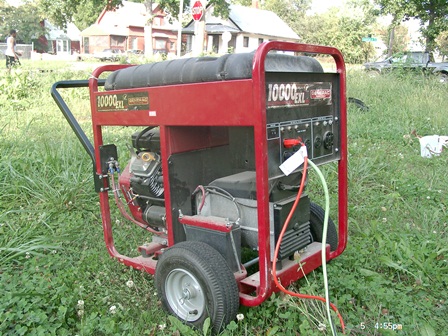 |
A small back-up electrical generator kicks in to help out if necessary... |
Even though the idea of using a gas fired generator is far from the ideal solar experience, the machine is only incorporated as a compromise to making required lifestyle changes. If you run a business from home, for example, it is not practical to shut your business down due to lack of electricity when a nstring of consecutive cloudy days doesn't allow your solar system to recharge. Likewise, you may have a big family event planned where the design of your solar system is temporarily inadequate for the number of people you will be accommodating.
In these cases, the backup generator kicks in to make up for the shortfall, used to charge the battery bank directly and assist the solar panels in their job to supply needed power. The generator is used for less than 5% of your annual power production, meaning that your carbon footprint reduction is still at 95% of what it would be without your solar system. Of course, you always have the option to not use the generator and ride out the low-power weather conditions until the next sunny day. You will, after all, always produce at least 20% of your system rated power output even on the cloudiest days.
The generator provides that sense of security of an uninterrupted power supply which allows the solar system to be designed economically and affordably.
Solar electrical systems and options
See our off-grid systems price ranges and how they can work for you
Below are some of our clients who are enjoying their off-grid experience, and, no OPG bills! This can be you - it is possible, affordable, and it is a lot of fun -- all the while you know you are helping reduce your carbon footprint!
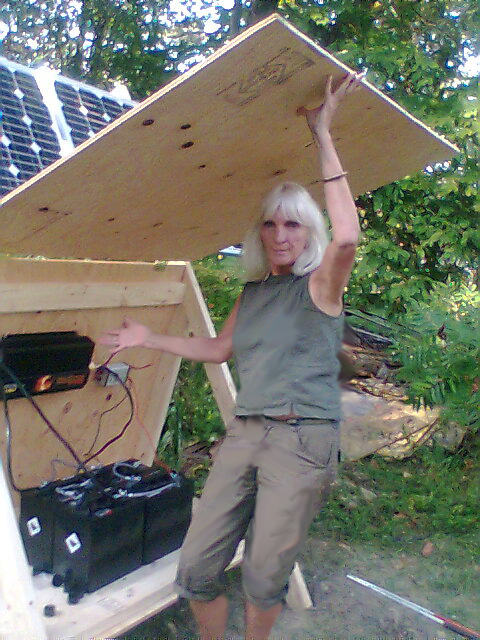
Maureen's power station
Maureen Walton is a mural artist working out of her studio in Eastern Ontario. She decided to have her art studio connected exclusively to Solar power. Working together with Maureen, we decided on the required power output, her budget considerations, and overall expectations of a solar system and then built the system together.
Click here to see how it is built

Maureen expands her power station in 2013...
Click here to see how her system was updated with a neat panel rack that rotates...
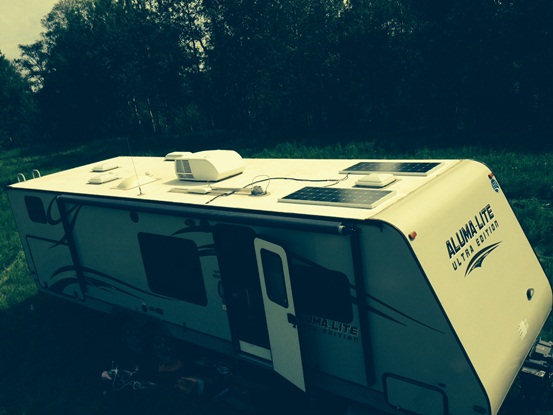
Ryan's RV Solar System
Ryan and his family often go camping on weekends in their luxurious RV. Keeping the battery bank charged and ready to go is easy thanks to the PV solar system supplied by Green-First...
Click here to read more on Ryan's RV system...
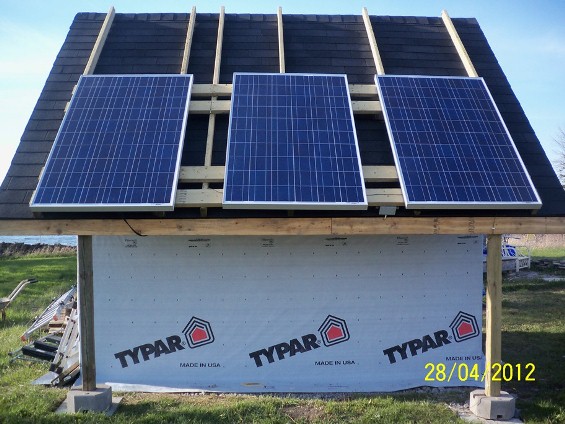
Kyle's Solar Power Station
Kyle lives in a remote area in a cabin which needed electricity. Together with Green-First, a system was designed according to need and budget with a full maintenance and replacement warrantee for 5 years. Kyle learned about the function of each component in the system during the construction process and continues to be informed of system operation to ensure he is well engaged and confident of his system's innermost workings.
Click here to see Kyle's system's picture galley
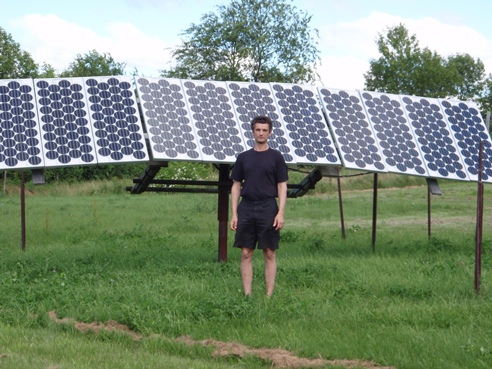
The Green-First Test System
CEO Jens Naumann builds a complete solar - wind electrical station in 1999 to demonstrate the viability of disconnecting from the Ontario Hydro electrical grid for power independence, power reliability, long term financial savings as well as reducing overall carbon footprint.
Click here to read more on this daring venture...
FIND OUT HOW YOU CAN GO GREEN AND SAVE MONEY!
Click here and discover our unique budget-oriented consultation service...
Contact us at info@green-first.com to book a power-saving
consultation now and SAVE!or call 613-354-0928 and talk to us...